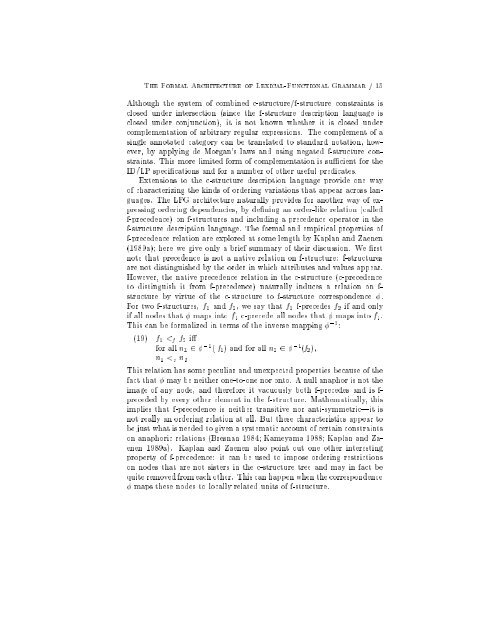The Formal Architecture of Lexical-Functional Grammar
The Formal Architecture of Lexical-Functional Grammar
The Formal Architecture of Lexical-Functional Grammar
You also want an ePaper? Increase the reach of your titles
YUMPU automatically turns print PDFs into web optimized ePapers that Google loves.
<strong>The</strong> <strong>Formal</strong> <strong>Architecture</strong> <strong>of</strong> <strong>Lexical</strong>-<strong>Functional</strong> <strong>Grammar</strong> / 15<br />
Although the system <strong>of</strong> combined c-structure/f-structure constraints is<br />
closed under intersection (since the f-structure description language is<br />
closed under conjunction), it is not known whether it is closed under<br />
complementation <strong>of</strong> arbitrary regular expressions. <strong>The</strong> complement <strong>of</strong>a<br />
single annotated category can be translated to standard notation, however,<br />
by applying de Morgan's laws and using negated f-structure constraints.<br />
This more limited form <strong>of</strong> complementation is su cient forthe<br />
ID/LP speci cations and for a number <strong>of</strong> other useful predicates.<br />
Extensions to the c-structure description language provide one way<br />
<strong>of</strong> characterizing the kinds <strong>of</strong> ordering variations that appear across languages.<br />
<strong>The</strong> LFG architecture naturally provides for another way <strong>of</strong>expressing<br />
ordering dependencies, by de ning an order-like relation (called<br />
f-precedence) on f-structures and including a precedence operator in the<br />
f-structure description language. <strong>The</strong> formal and empirical properties <strong>of</strong><br />
f-precedence relation are explored at some length by Kaplan and Zaenen<br />
(1989a) here we give only a brief summary <strong>of</strong> their discussion. We rst<br />
note that precedence is not a native relation on f-structure: f-structures<br />
are not distinguished by the order in which attributes and values appear.<br />
However, the native precedence relation in the c-structure (c-precedence<br />
to distinguish it from f-precedence) naturally induces a relation on fstructure<br />
by virtue <strong>of</strong> the c-structure to f-structure correspondence .<br />
For two f-structures, f1 and f2, wesaythatf1 f-precedes f2 if and only<br />
if all nodes that maps into f1 c-precede all nodes that maps into f2.<br />
This can be formalized in terms <strong>of</strong> the inverse mapping ;1 :<br />
(19) f1 < f f2 i<br />
for all n1 2 ;1 ( f1) and for all n2 2 ;1 (f2),<br />
n1 < c n2<br />
This relation has some peculiar and unexpected properties because <strong>of</strong> the<br />
fact that may be neither one-to-one nor onto. A null anaphor is not the<br />
image <strong>of</strong> any node, and therefore it vacuously both f-precedes and is fpreceded<br />
by every other element in the f-structure. Mathematically, this<br />
implies that f-precedence is neither transitive noranti-symmetric|it is<br />
not really an ordering relation at all. But these characteristics appear to<br />
be just what is needed to given a systematic account <strong>of</strong> certain constraints<br />
on anaphoric relations (Bresnan 1984 Kameyama 1988 Kaplan and Zaenen<br />
1989a). Kaplan and Zaenen also point out one other interesting<br />
property <strong>of</strong> f-precedence: it can be used to impose ordering restrictions<br />
on nodes that are not sisters in the c-structure tree and may in fact be<br />
quite removed from each other. This can happen when the correspondence<br />
maps these nodes to locally related units <strong>of</strong> f-structure.

















